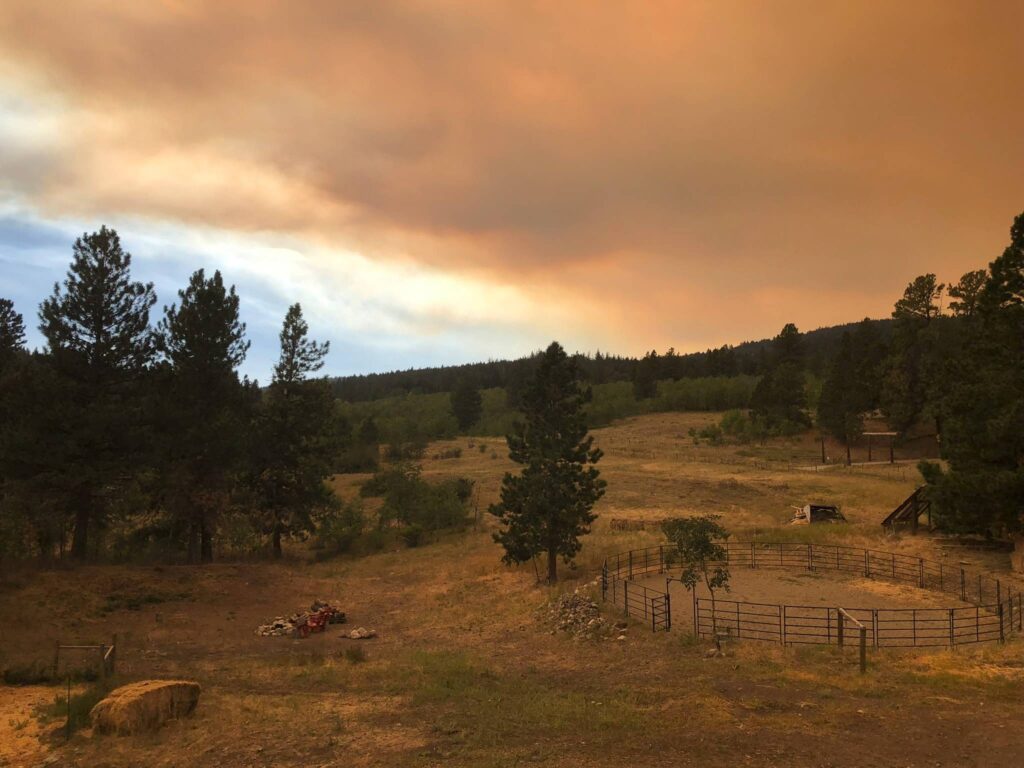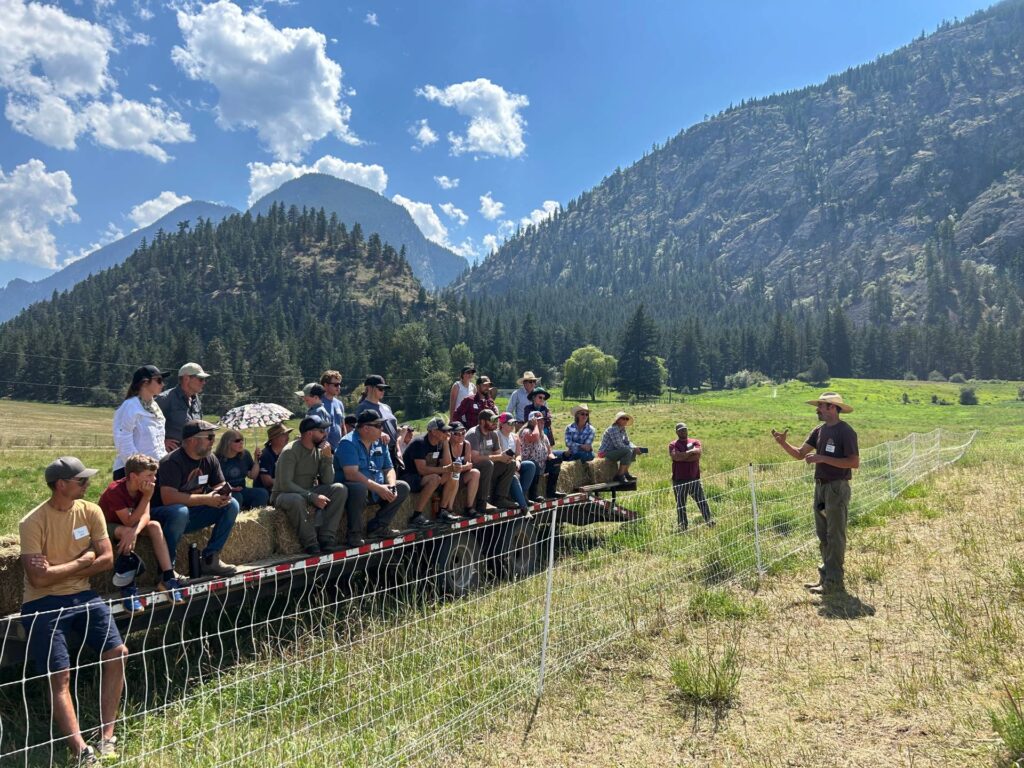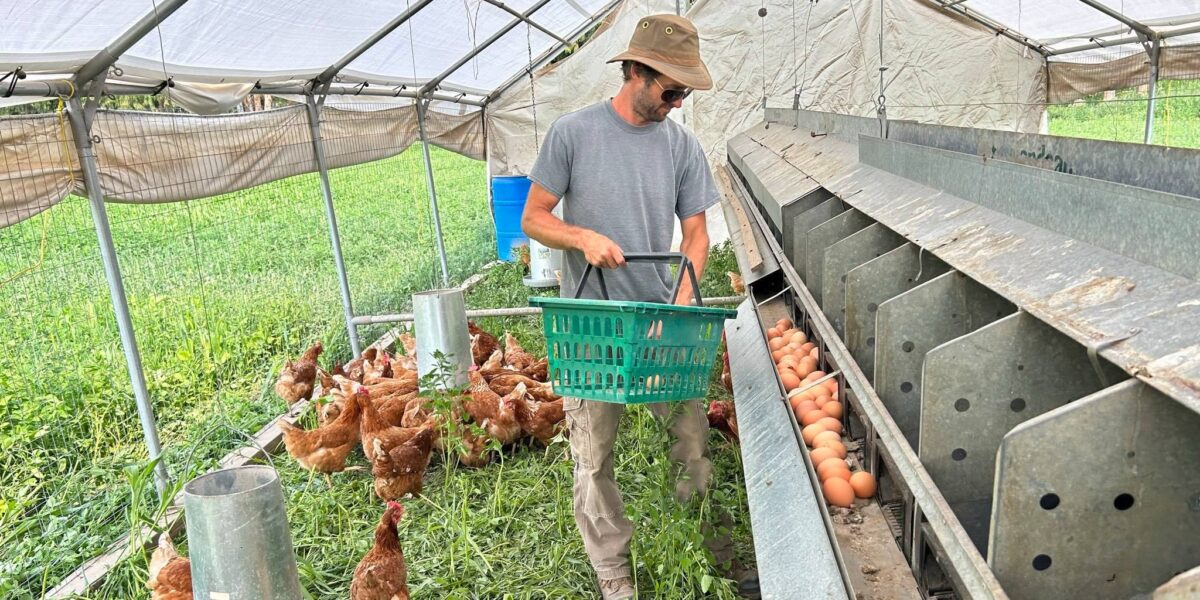Alongside unprecedented wildfires, farmers in BC, Alberta and Saskatchewan have been dealing with a devastating drought that has affected crop yields and livestock feed.
Conditions have deteriorated for the past two years, including the 2021 heat dome that led to the deaths of nearly six hundred people in BC.
Julia Smith, founding member and executive director of the Small-Scale Meat Producers Association in BC and a board member of Farmers for Climate Solutions, and runs Blue Sky Ranch just outside of Merritt, BC. She said her farm has been without water for two months.
“It’s really bad. I had to sell my cows. I can’t afford to feed them because hay prices have just been insane due to drought and heat dome,” Smith said. “We haven’t recovered from two years ago.”
Steve Meggait, who operates Fresh Valley Farms and serves as Vice President of the Small Scale Meat Producers association, has also been directly affected by drought conditions for the past two years.
“We had a very wet spring. But then once we came into July, it was just bone dry the whole time. So it was a bit shorter of a drought, but it went late into the season,” Meggait said. “It’s an ongoing drought situation that affects everything from our groundwater supply to just the general ecological systems around here”
“Anywhere that’s not irrigated, it’s not just that the plants aren’t growing, I think that the soil is also suffering a lot,” he said.
Worsening conditions and little help
Drought conditions have affected farmers beyond BC. Some areas in Saskatchewan have faced drought conditions for the past five growing seasons, which have dramatically affected the livelihood of farmers in the province.
The drought conditions have been worsened by an unprecedented wildfire season, which has burned more than 153,000 square kilometres in the country. The wildfire smoke and heat has directly affected Meggait, who said the combination of smoke and heat killed fifty pasture chickens, about 10 per cent of the flock.
READ MORE: 2023 is the year Canada went up in smoke
The effects of the drought have been prolonged and significant. In 2022, Canada’s cattle herd fell to 12.3 million animals, the lowest level since 1988. By the end of July, two-thirds of the water basins in BC are at Drought Level 4 or 5. The BC government describes these levels as “Adverse impacts to socio-economic or ecosystem values are likely” in level 4 and “almost certain” in level 5.
Earlier this month, Farm Credit Canada (FCC) announced they would provide support to farmers in BC, Alberta, Saskatchewan and Manitoba who have been financially impacted by the drought conditions. In a news release, the FCC said “Crops are at a critical state with extremely dry and hot weather creating adverse conditions in parts of all four provinces. Depending on the area, quality and yield are expected to be significantly reduced by drought.

On August 21, the federal government announced a moderate tax deferral to help farmers. This will be available for designated regions in BC, Alberta, Saskatchewan and Manitoba that have suffered due to the drought. The provision allows farmers to defer a portion of their sales income until next year.
“The government stands with farm families during this difficult time and is taking action to respond,” the government announced in a press release.
The BC government also announced an Access to Feed program alongside the BC Cattlemen’s Association to help coordinate hay and feed sellers in the US with Canadian farmers who need the assistance. The feed will still cost farmers more due to skyrocketing prices, with large bales going from $65 last year to $130 in 2023. These price increases have directly affected farmers like Smith.
“For those of us that are feeding grains to chickens and pigs, those prices have gone through the roof as well, and are anticipated to get worse because they’re having their own droughts in the prairies where those grains are grown,” Smith said. “You just can’t pay that.”
But the process to apply for relief is complicated for smaller farmers. In one case, the deadline to apply for funding from the Water Infrastructure program was exceedingly difficult. Meggait said that smaller farms don’t have the resources to dedicate towards navigating the system.
“My partner here has a master’s degree in stuff like this,” Meggait said. “She’s in the office half the time just dealing with grants trying to get government help. We do need it. We’re on the frontlines of this climate change disaster and we need help.”
Smith agreed, and said that bureaucratic rules have prevented funds from getting to smaller farmers that would benefit most from these measures.
“The people that really need it are the people that don’t have the resources to navigate the quagmire of government funding,” said Smith.
Sean Smukler is an associate professor in applied biology and soil science at University of British Columbia (UBC) and director of the Centre for Sustainable Food Systems at UBC Farm. While he did not comment on the new initiatives specifically, he said that, while governments have attempted to preemptively tackle the impacts of climate change in a precarious position, they aren’t succeeding.
“The amount of dollars that’s going to address this situation is embarrassing. We are facing a climate emergency and we’re pretending like it’s something that’s for the next generation to deal with,” he said. “No one grasps the fact that, if we don’t deal with it now, the next generation can’t deal with it.”
Systemic change needed to adapt
In a tough situation, Smith and Maggait are working to institute techniques to adapt to new and often unpredictable conditions.
One of these includes rotational grazing, which mimics herd animal patterns in a natural environment. Herd animals would graze an area before moving onto another pasture. During grazing, they would leave behind manure and churn up soil, allowing it to trap more carbon and moisture into the land. Smith said this method replicates patterns of bison and elk in North America before the modern period, and allows cow herds to be more environmentally sustainable.
“The cows get thrown under the bus all the time in these climate change discussions, and we’re really throwing the baby out with the bathwater,” Smith said. “We need to have a conversation about how we can change our agricultural management practices to be part of the climate change solution.”
While Smukler called rotational grazing “a promising practice,” he said that the agriculture industry also needs to reduce carbon emissions to effectively combat climate change, which the practice may not promote, especially in the context of high demand for meat.
“While rotational grazing might do a great job in reducing those emissions by sequestering carbon in soil and maybe even reducing the emissions coming from animals, it’s not clear if that’s going to be enough to meet our emission targets or even the demand for meat,” he said.
Maryse Bourgault is an assistant professor at the college of Agriculture and Bioresources at University of Saskatchewan and integrated agronomy research chair of the Western Grains Research Foundation. She said droughts are complicated by factors like timing of rainfall, and the ability of soil to retain water, but there is research underway to adapt to the effects of climate change.
“We’re trying to get crops that do the most with what they have, and so we have the genetics part that we can improve,” Bourgault said.
Another method is simply to manage crops and crop systems differently. This includes planting more crops like peas and lentils that use less water, or sunflower and alfalfa that have deeper root systems. This would also tackle issues with pests like grasshoppers.
“For example, when we have barley, it seems that the grasshoppers love barley, they all go in there. But if you only have barley, then perhaps that’s more problematic,” Bourgault said.
“Whereas if you have barley, you have wheat, you have peas, you have canola, you might have another mustard or sunflower or flax, you build your portfolio. if you will have different products you have different commodities that you have to sell,” she said.
Meggait agreed that diversifying crops is a tactic that needs prioritization in the agriculture industry.
“I think we just need more life on the planet, that’s the key thing to me. Mono cropping large patches of land, you might as well just have paved it over, because it’s not performing any real ecosystem or climate service,” he said. “Whereas a big chunk of living biomass of many, many species has all kinds of ecosystem services that will help us survive this.”
The looming threat to food supply
Though food security isn’t an immediate concern in regards to the agricultural situation in BC, the deteriorating situation could affect the supply of crops and meat to grocery stores in the future.
Smukler said this threat is dependent on the type of crop. Canada has a reliable supply of grains which will unlikely be affected by shortages, but that doesn’t apply to other foods this country imports, like fruits and vegetables.
“That’s certainly at stake at this point. We import a sizable amount of fruits and vegetables into Canada and we’re not doing a great job of developing local food systems,” he said.
When asked about whether he sees Canada’s food supply being threatened in the near future, Meggait replied directly. “Yes. It’s just straight up, yes,” he said.
Smukler pointed to imports of lettuce from California and Mexico, where climate change has also affected agriculture, as threats to supply in the future.
“We could be using our crop lands to produce vegetables other than salad and freeze them for the winter time. We don’t have to have year-round fresh fruits and vegetables to meet our dietary needs,” Smukler said.

“There’s lots of work being done on indoor production. I think that will put a dent in some areas, maybe we’ll be able to grow lettuce indoors. But for the vast majority of our demands, I think that’s going to be a long time before that’s a possibility and I think there’s some serious energy constraints that go along with that,” he said. ”Absolutely we can’t be pumping more carbon dioxide in the atmosphere to make that happen.”
Smith also has concerns about relying on food imports to feed people in Canada, especially with dwindling numbers of farmers working in the industry.
“I’m not sure I’m super comfortable relying on California to feed us with the situations that they’re having down there being so similar to what we’re experiencing here,” she said. “But local food supplies are definitely threatened in that we’re losing farmers. Every year there are fewer and fewer farmers in Canada.”
Hope and dread for the future
Though the situation looks dire, there are reasons to be hopeful, if the right measures are taken.
Smukler referred to institutions like the BC Agricultural Climate Action Research Network, a network of researchers, producers and government employees that work towards solutions for agriculture workers. He also said that Canada has the capacity to produce crops domestically if that tactic were to be pursued. He also believes that these goals are possible to achieve, as long as Canadians use “money and people power” towards them.
“There’s some action being taken and I am certainly hopeful that we can mobilize, we can tackle some of these challenges,” Smukler said. “A lot of it is not rocket science.”
Bourgault acknowledged that the new normal “is less predictable,” and adaptations will need to be made year-to-year, unlike in the past. But she also mentioned the inspiration she feels when seeing younger students enter into the field.
“That was me 20 years ago, maybe I’m a bit more cynical about it. But it’s really good to see young people being committed, having the right kind of values and being confident in their ability to change things,” she said. “I think you have to see progress as one step at a time and we do see those steps.”
Farmers like Meggait and Smith face the brunt of these conditions, as they have been struggling to keep up their work with dwindling manpower, finances and benefits that are difficult to access. But even still, they know there’s a path to improve the situation.
“We need to have a fundamental systemic shift in our priorities and values. Because if farms like these can’t survive and become economically viable, like we really don’t have much hope,” Smith said.
“It’s still important that we keep trying, because, like I say, there’s going to come a day when there’s no food on the grocery store shelves,” Meggait said. “It’s just going to happen.”
Editor’s note 2023/08/25: This article originally stated that Julia Smith was Executive Director of Farmers for Climate Solutions. Julia is in fact the Executive Director of Small-Scale Meat Producers Association in BC. rabble regrets the error.



